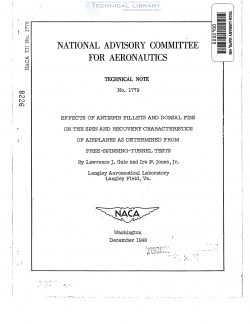naca-tn-1779
- Version
- 122 Downloads
- 988.16 KB File Size
- 1 File Count
- December 6, 2016 Create Date
- December 6, 2016 Last Updated
National Advisory Committee for Aeronautics, Technical Notes - Effects of Antispin Fillets and Dorsal Fins on the Spin and Recovery Characteristics of Airplanes as Determined from Free Spinning Tunnel Tests

The effects of antispin fillets and dorsal fins on the spin and
recovery characteristics of airplanes have been determined from an
analysis of the results of spinning investigations of a large number of
models tested in the Langley 15-foot and 20-foot free-spinning tunnels.
The analysis'indicated that when antispin fillets were installed
on an airplane, the fuselage area below the fillets became more effective
in damping the spinning rotation (higher tail-damping ratio). Whether
or not fillets satisfactorily improved recovery characteristics of a
given design depended, with few exceptions, upon the tail—damping power
factor of the design with fillets installed and upon the mass distribution
and relative density of the airplane. The results indicated that dorsal
fins generally had little effect on spin and recovery characteristics.
During approximately 13 years of operation of the Langley 15-foot
and 20-foot free-spinning tunnels, model tests have been made for approxi-
mately 200 different military airplane designs to determine their spin
and recovery characteristics. During these tests the various flying
conditions of the airplane were usually investigated, and when the
results indicated that the spin and recovery characteristics‘would be
unsatisfactory, dimensional modifications were made to the model and
recommended for the airplane such that the final design would possess
satisfactory spin and recovery characteristics. The recommended
modifications, in most cases, consisted of increasing the tail length,
raising the horizontal tail, or adding a ventral fin. For some cases,
however, these modifications were not considered feasible and other
modifications were studied. One such modification that was found
effective in improving the spin-recovery characteristics was the installa-
tion along the fuselage of narrow extensions of the horizontal stabilizer
designated as antispin fillets. An analysis of the results of tests
of such fillets has been made in order to determine the important factors
governing their action.
| File | Action |
|---|---|
| naca-tn-1779 Effects of Antispin Fillets and Dorsal Fins on the Spin and Recovery Characteristics of Airplanes as Determined from.pdf | Download |
Comment On This Post